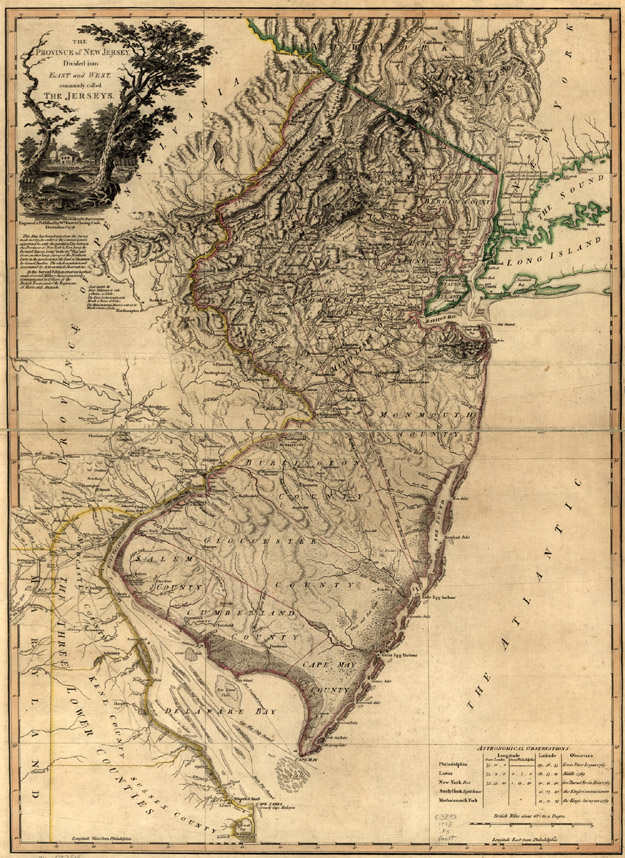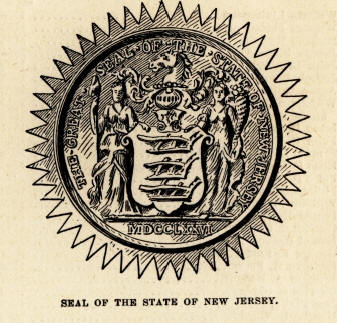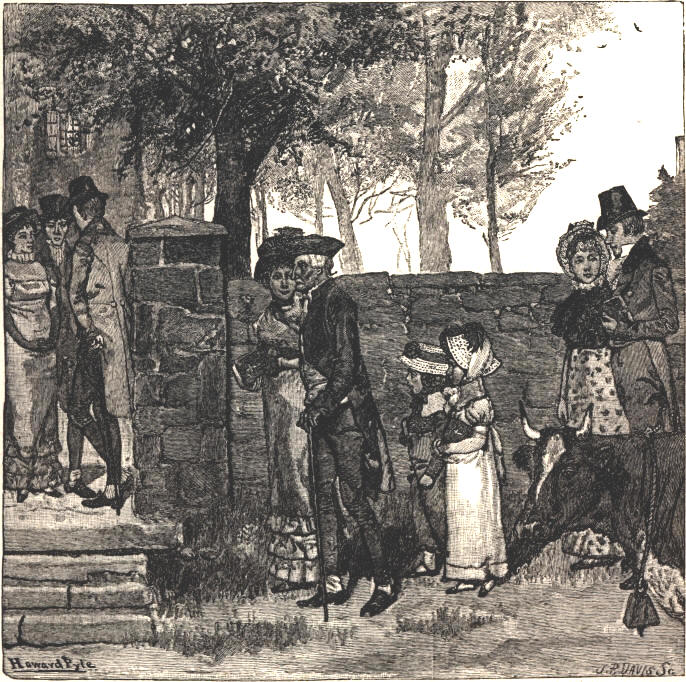New Jersey
|
|
This Site:
|
1769 Map of the New Jersey Colony
Settlements under Nicolls's grants had already been begun at Newark, Middletown, and Shrewsbury, when news of the grant reached New York. Nicolls was amazed at the folly of the duke in parting with such a splendid domain, which lay between the two great rivers and extended north from Cape May to lat. 40° 40'. The tract was named New Jersey in compliment to Carteret. The new proprietors formed a constitution for the colonists. Philip Carteret, cousin of Sir George, was sent over as governor of New Jersey, and emigrants began to flock in, for the terms to settlers were generous, and the constitution was satisfactory. The governor gave the hamlet of four houses where he fixed his seat of government the name of Elizabethtown, in compliment to the wife of Sir George, and there he built a house for himself. A conflict soon arose between the settlers who had patents from Nicolls and the new proprietors, and for some years there were frequent quarrels. Other settlers were rapidly coming in, and in 1668 the first legislative assembly met at Elizabethtown, and was largely made up of representatives of New England Puritanism. When, in 1670, quit-rents were demanded of the people, discontent instantly appeared, and disputes about land-titles suddenly produced much excitement. Some of the settlers had bought of the Indians, some derived their titles from original Dutch owners, others received grants from Nicolls, and some from Berkeley and Carteret, the proprietors. Those who settled there before the domain came under the jurisdiction of the English united in resisting the claim for quit-rent by the proprietary government. The people were on the verge of open insurrection, and only needed a leader, when James, the second son of Sir George Carteret, arrived in New Jersey. He was on his way to South Carolina. He was ambitious, but dissolute and unscrupulous, and was ready to undertake anything that promised him fame and emolument. He put himself at the head of the malcontents who opposed his cousin Philip, the governor, who held a commission from Sir George. The insurgents called an assembly at Elizabeth-town in the spring of 1672, formally deposed Philip Carteret, and elected James their governor. Philip, in the early summer, sailed for England and laid the matter before his superiors. He knew the administration of his cousin would be a chastisement of the people, as it proved to be, for he was utterly incompetent, and his conduct disgusted them. Before orders came from England the insurgents were ready to submit to Philip Carteret's deputy, Captain Berry (May, 1673) , and James Carteret immediately sailed for Virginia. Philip Carteret returned next year as governor, made liberal concessions in the name of Sir George, and was quietly accepted by the people. Among the purchasers of a portion of New Jersey were John Fenwick and Edward Billinge, both of the Society of Friends. These men quarreled with regard to their respective rights. The tenets of their sect would not allow them to go to law, so they referred the matter to William Penn, whose decision satisfied both parties. Fenwick sailed for America to found a colony, but Billinge was too much in debt to come, and made an assignment for the benefit of his creditors. The greater part of his right and title in New Jersey fell into the hands of Penn, Gawen Lawrie, and Nicholas Lucas. The matter was now complicated. Berkeley had disposed of his undivided half of the colony. Finally, on July 1, 1676, after much preliminary negotiation, a deed was completed and signed by Carteret on the one side, and Penn, Lawrie, Lucas, and Billinge on the other, which divided the province of New Jersey into two great portions-east Jersey, including all that part lying northeast of a line drawn from Little Egg Harbor to a point on the most northerly branch of the Delaware River, in lat. 41° 40' N.; and west Jersey, comprehending all the rest of the province originally granted by the Duke of York. East Jersey was the property of Sir George Carteret; west Jersey passed into the hands of the associates of the Society of Friends. West Jersey was now divided into 100 parts, the proprietors setting aside ten for Fenwick, who had made the first settlement, at Salem, on the Delaware, and arranging to dispose of the remainder for the benefit of Billinge's creditors.
Quakers Going to Church in Colonial TimesMeanwhile, a large immigration of Quakers from England had occurred, and these settled below the Raritan, under a liberal government. Andros required them to acknowledge his authority as the representative of the duke, but they refused, because the territory had passed out of the possession of James. The case was referred to Sir William Jones, the eminent jurist and Oriental scholar, who decided in favor of the colonists. The first popular Assembly in west Jersey met at Salem in November, 1681, and adopted a code of laws for the government of the people. Late in 1679 Carteret died; and in 1682 William Penn and others bought from his heirs east Jersey, and appointed Robert Barclay governor. He was a young Scotch Quaker and one of the purchasers, who afterwards became one of the most eminent writers of that denomination. Quakers from England and Scotland and others from Long Island flocked into east Jersey, but they were compelled to endure the tyranny of Andros until James was driven from his throne and the viceroy from America, when east and west Jersey were left without a regular civil government, and so remained several years. Finally, wearied with contentions and subjected to losses, the proprietors surrendered the domain of the Jerseys to the crown (1702), and the dissolute Sir Edward Hyde (Lord Cornbury) , governor of New York, ruled over the province. Politically, the people were made slaves. It remained a dependency of New York until 1738, when it was made an independent colony, and so remained until the Revolutionary War. Lewis Morris, who was the chief-justice of New Jersey, was commissioned its governor, and was the first who ruled over the free colony. William Franklin, son of Benjamin Franklin, was the last of the royal governors of New Jersey. A conditional State constitution was adopted in the Provincial Congress at Burlington, July 2, 1776, and a State government was organized with William Livingston as governor. After the
battle of Princeton and the retreat of
the British to New Brunswick, detachments of American militia were
very active in the Jerseys. Four days after that event nearly fifty Waldeckers (Germans) were killed, wounded, or made prisoners at
Springfield. General Maxwell surprised Elizabethtown and took nearly
100 prisoners. General Dickinson, with 400 New Jersey militia and
fifty Pennsylvania riflemen, crossed Millstone River near Somerset
Courthouse (June 20, 1777), and attacked a large British foraging
party, nine of whom were taken prisoners; the rest escaped, but
forty wagons, with much booty, fell into the general's hands. About
a month later, Colonel Nelson, of New Brunswick, with a detachment
of 150 militiamen, surprised and captured at Lawrence's Neck a major
and fifty-nine privates of a Tory corps in the pay of the British. |
|
|
||
|
|
Site Copyright 2003-2018 Son of the South. For Questions or comments about this collection, contact: paul@sonofthesouth.net |
|
|
Are you Scared and Confused? Read My Snake Story, a story of hope and encouragement, to help you face your fears. |
||

 New
Jersey, STATE OF, was one of the
New
Jersey, STATE OF, was one of the
